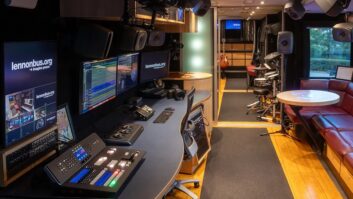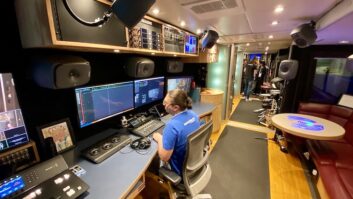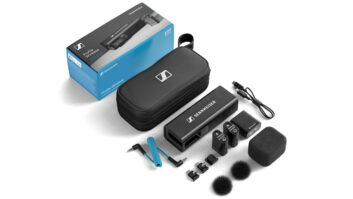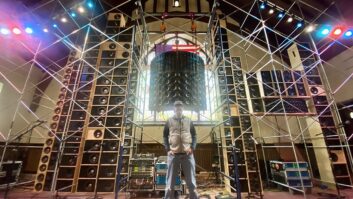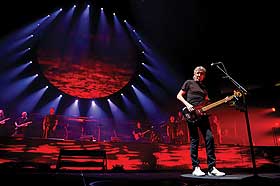
Roger Waters (far right) performing with the rest of “The Wall” band
Photos: Steve Jennings
It’s been 30 years since Roger Waters penned Pink Floyd’s mind-blowing album The Wall. Fast-forward to today, and the same political issues, fear and stress on global matters that formed the basis of that album are still quite relevant—and Waters demonstrates this in his jaw-dropping, two-hour (with half-hour intermission) show. The double-disc album—played in its entirety on this tour—concentrates on the walls people build around themselves for survival. While this may seem like a purely philosophical topic, Waters also brings it into physical reality: By the time the first-half of his performance is complete, a 36-foot wall made of cardboard boxes has been erected onstage. Of course, the wall comes crashing down at the end of the second-half. As each box is put into its place, the audience’s view of the band and Waters is slowly blurred out. Each box also displays occasionally chaotic video images, some of which include pictures of armed forces casualties, snippets from the original The Wall video, and B-52 bombers dropping crosses, stars of David, Islamic crescents and logos of Shell Oil and Mercedes Benz.
It’s a visually stunning experience with top-notch sound, helped out by the incredible backing band: guitarists Dave Kilminster, G.E. Smith and Snowy White; background vocalists Mark Lennon, Michael Lennon, Kipp Lennon and Jon Joyce; keyboardists Harry Waters—Waters’ son—and Jon Carin; drummer Graham Broad; and, of course, Waters on bass. Taking care of David Gilmour’s vocal parts is second lead singer Robbie Wyckoff.

FOH engineer/tour manager Trip Khalaf (right) with crew chief/system engineer Robert Wiebel
Tour manager/front-of-house engineer Trip Khalaf has been mixing for Waters since 1999, watching the artist become more comfortable in the limelight. “In 1999, he hadn’t done a show in 10 years and nobody knew what to do with it,” Khalaf recalls. “It was odd because Pink Floyd always tried to avoid the spotlight, so no one really knew who was in the band, except for the real diehards. It has been interesting watching it grow to what it is now.”
ANALOG RULES AT FOH
For this run of 94 dates, Khalaf is manning three boards: a Midas XL4 to handle the stereo P.A. (more on that later), another XL4 to cover the band and the end of the second-half, and a Yamaha PM5D for surrounds and effects. “For the analog side of it, it’s because of the number of inputs,” Khalaf says. “There are two bands, really. The front XL4 does all of the main stage—which is behind the wall—and the one on the left [another XL4] does all of the surrogate band, the forestage.” Inside the effects rack are Lexicon 480s and PCM91s, TC Electronic D-Twos, an H3000, a Helicon vocal double, Aphex gates on drums, Crane Song STC8 on basses, TLA100s on vocals and dbx 900 on background vocals. Why XL4s? Khalaf replies: “Because I’m tired of pretending that digital audio sounds as good as analog. It doesn’t. This record was made when people cared deeply about sound quality. These days, that is not as important as the size of the video screen on your console. If it comes at me analog, it will stay analog.”
Those surround speakers are Clair R4s clustered in three configurations—left, right and rear—that handle the playback and sound effects, provided by playback engineer Mike McKnight. “They’re there so that there’s something happening for everybody,” says crew chief/system engineer Robert Wiebel. “We’ve had quite good luck with them; they sound good.” Adds Khalaf, “The Yamaha takes care of all the surround stuff, which comes from a hard disk operator [Mike McKnight]. We tried carrying around live pigeons to make pigeon noises but it didn’t work, so we put them on hard disk. [Laughs] It also gives me the opportunity because all of the effects are digital anyway; I just bring them back into the Yamaha and leave them all there. All of the surround effects need to be controlled all the time, mostly because the height of those surround clusters varies from building to building. I have the VCAs linked between the two XL4s so that I can more or less control that left-hand board from the main board.

Monitor tech/RF tech Kevin Kapler
“I actually have snapshots in the analog board using the VCAs and the mutes,” he continues. “But you have to turn up the guitar solos and maybe the drummer’s laying out a little bit. It’s mixing the show; things aren’t always the same every night. I always change my approach a little bit. ‘Okay, I mixed it this way last night and it was pretty good, but let’s feature this a little bit and pull it out.’ It’s a constant rethink where you are and reacting to different buildings. I’m trying to maintain the balance of the chaos that is with mixing any band. This one’s a bit less chaotic than most; actually, not that chaotic—they’re a great band.”
The forward-thrusting P.A. is a prototype Clair i5D. Explains Khalaf, who has been a senior engineer at Clair for the past 37 years: “We’re the guinea pig. I like it a lot; it’s a bit more coherent. The original i4 was one 18, four 10s and a couple of horns. There’s two philosophies to this. You can either put a lot of low end into the air, which really pisses off lighting designers, or you stack a bunch of sub-lows on the floor and beat the people in the first 10 rows half to death. Clair’s philosophy has always been to put as much of the low end in the air as you can and use the sub-lows simply as an add-on to move a bit of the air and couple more effectively with the floor. Putting all that stuff into one box gave us the opportunity to smooth out a lot of the anomalies with the original cabinets. The problem with it is that it’s big. We were a bit worried about it when we first started, but we found it’s smaller than a staging dolly, so no one really cared. I wouldn’t want to push one of those across a field in Montenegro…actually, keep me out of Montenegro.” In addition, there are eight i5s for side coverage, 12 B218 subs under the stage and eight FF2s as front-fills. All of this is powered by Crown analog amps.
ALL DIGITAL ON THE MONITOR FRONT
Whereas FOH is a mostly-analog affair, monitor world maintains a purely digital approach. Monitor engineer Robin Fox mans a DiGiCo SD7, working with around 60 inputs for all 16 ear mixes (on JH Audio in-ears) and the 42 12AM Series 2 wedges; monitor amps are Lab.gruppen 20ks. Monitor tech/RF tech Kevin Kapler says that they are scanning for about 42 operating channels of wireless, though he calculates for about 54. Kapler uses a TTi handheld analyzer with an A04 8200 scanner. For the Sennheiser 2000 Series transmitters, he uses a Pro Wireless IE5 program to coordinate the frequencies, citing that the beauty of this system is that he can sync it.
Included in his wireless roundup are the mic models, which include a Shure U4D (though both Waters and Wyckoff will also sing through a hard-wired 58) and wireless Shure mics for background vocals. “We’ve got about a half-dozen wireless just for the acoustic instruments,” Kapler adds. “This includes all the wireless for the end of the show, where the musicians will come out with an accordion, ukulele, et cetera.”
While Waters is very involved in the sound of his show (they record a DVD each night that he’ll review for any tweaks; in fact, Khalaf says they haven’t nailed down the arrangements quite yet), the artist and FOH engineer have a great working relationship that allows Waters to do what he does best and to give Khalaf the air to mix the show as he sees fit. “He’s absolutely involved, but the great thing about being a front-of-house engineer in the final analysis is that the artist has no idea what you’re doing out there; they just have to trust you,” Khalaf says. “He lets me do what I want to do. This is one of the last great traditional rock ’n’ roll tours. I sometimes wonder if I’ll ever be able to do something this rewarding again.”
Sarah Benzuly is
Mix
’s managing editor.


